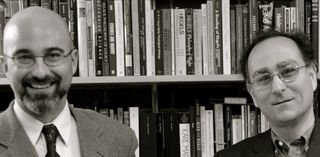From 3:AM Magazine:
 Robert B. Talisse (on the right of the picture) and Scott F. Aikin (on the left of the picture) are the dynamic duo of 3Quarksdaily, thinking about the social nature and political significance of argument, about the two things the word ‘argument’ captures, about the straw man fallacy, about misfiring sound arguments, about the intimate connection between epistemology and democracy, about the nature of democracy, pragmatism and Rawls, about Dewey, Elizabeth Anderson and Pierce, about ‘pluralism’ as a halo term, about the truth orientation of our cognitive life, about Nietzsche’s challenge, about being fearless about the fear of regress, about the use of tone, about the need for political arguers and the dangers of cognitive insulation, about when to revise ones beliefs, about civility in argument and about why their new book is keyed to all contemporary democracies. Epistemocracy doubled!
Robert B. Talisse (on the right of the picture) and Scott F. Aikin (on the left of the picture) are the dynamic duo of 3Quarksdaily, thinking about the social nature and political significance of argument, about the two things the word ‘argument’ captures, about the straw man fallacy, about misfiring sound arguments, about the intimate connection between epistemology and democracy, about the nature of democracy, pragmatism and Rawls, about Dewey, Elizabeth Anderson and Pierce, about ‘pluralism’ as a halo term, about the truth orientation of our cognitive life, about Nietzsche’s challenge, about being fearless about the fear of regress, about the use of tone, about the need for political arguers and the dangers of cognitive insulation, about when to revise ones beliefs, about civility in argument and about why their new book is keyed to all contemporary democracies. Epistemocracy doubled!
3:AM: What made you become philosophers?
Scott Aikin: I was a Classics major at Washington University in St. Louis, and I was very lucky to have the patient instruction of Merritt Sale, George Pepe, and Carl Conrad there. We would have class discussion about some line from Seneca or Plato, and I’d get hung up on some philosophical issue. I originally thought it was because my ancient languages weren’t good enough, but it became clear that disagreements about virtue or knowledge aren’t solved by dictionaries, but by doing some philosophical work. You had to think about what virtue and knowledge really are. It was like my mind caught fire – I was eighteen years old and could dispute with the greats on what was good and true. Authority with these matters came with having reason on your side, not any status or anything like that. It was exhilarating, and that anti-authoritarian appeal of philosophical work still enlivens me.
Robert Talisse: I grew up in northeastern New Jersey, and I took a class in Philosophy in my senior year in high school. The class was a survey of the great philosophers’ ideas, paying nearly no mind to the arguments they devised. I liked that class, but it left me with the impression that Philosophy was a dead discipline, something that had ended in the 19th Century. So, when I entered William Paterson College (it was not yet a university then), I was not aware that it was possible to major in Philosophy. I spent my first semester as an Economics major, but once I discovered that there was a Philosophy major, I switched immediately. At the time William Paterson was a small commuter school filled with Business majors, yet somehow there was a critical mass of really serious Philosophy students, all of whom eventually earned PhDs, and many of whom are now professional philosophers. In any case, I quickly learned there that Philosophy is about challenging those (including oneself) who claim to know. Like Aikin, I latched on to the anti-authoritarianism of it all. And I soon realized that the impression of Philosophy that I got from my high school class – that it had died as a discipline – was exactly wrong. Philosophy is one of the few disciplines that is not dead. I eventually found myself with a PhD in Philosophy from CUNY and a job at Vanderbilt as a philosopher. To be honest, I’m not really sure how it all happened.
More here.
Tom Whipple at More Intelligent Life:
